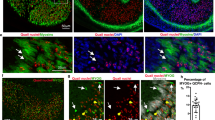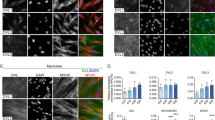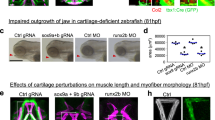Abstract
LIMB muscles develop from cells that migrate from the somites1,2. The signal that induces migration of myogenic precursor cells to the limb emanates from the mesenchyme of the limb bud2,3. Here we report that the c-met-encoded receptor tyrosine kinase is essential for migration of myogenic precursor cells into the limb anlage and for migration into diaphragm and tip of tongue. In c-met homozygous mutant (-/-) mouse embryos, the limb bud and diaphragm are not colonized by myogenic precursor cells and, as a consequence, skeletal muscles of the limb and diaphragm do not form. In contrast, development of the axial skeletal muscles proceeds in the absence of c-met signalling. The specific ligand of the c-met protein, the motility and growth factor scatter factor/ hepatocyte growth factor4–9, is expressed in limb mesenchyme and can thus provide the signal for migration which is received by c-met. We have therefore identified a paracrine signalling system that regulates migration of myogenic precursor cells.
This is a preview of subscription content, access via your institution
Access options
Subscribe to this journal
Receive 51 print issues and online access
$199.00 per year
only $3.90 per issue
Buy this article
- Purchase on SpringerLink
- Instant access to full article PDF
Prices may be subject to local taxes which are calculated during checkout
Similar content being viewed by others
References
Turing, A. M. Phil. Trans. R. Soc. B237, 37–72 (1952).
Kauffman, S. A. in Pattern Formation (eds Malacinsky, G. M. & Bryant, S.) 73–102 (Macmillan, New York, 1984).
Meinhardt, H. Models of Biological Pattern Formation (Academic, London, 1982).
Murray, J. D. Scient. Am. 258, 80–87 (1988).
Winfree, A. T. Nature 352, 568–569 (1991).
Lengyel, I. & Epstein, I. R. Science 251, 650–652 (1991).
Ouyang, Q. & Swinney, H. L. Nature 352, 610–612 (1991).
Pool, R. Science 251, 627 (1991).
Dawes, E. A. Quantitative Problems in Biology (Longman, London, 1956).
Bunning, E. & Sagromsky, H. Z. Naturf. B3, 203–216 (1948).
Lacalli, T. C. Phil. Trans. R. Soc. B294, 547–588 (1981).
Meinhardt, H. Rep. Progr. Phys. 55, 797–849 (1992).
Segel, L. A. & Jackson, J. L. J. theor. Biol 37, 545–549 (1972).
Wigglesworth, V. B. J. exp. Biol. 17, 180–200 (1940).
Meinhardt, H. Development (suppl.) 107, 169–180 (1989).
Author information
Authors and Affiliations
Rights and permissions
About this article
Cite this article
Bladt, F., Riethmacher, D., Isenmann, S. et al. Essential role for the c-met receptor in the migration of myogenic precursor cells into the limb bud. Nature 376, 768–771 (1995). https://doi.org/10.1038/376768a0
Received:
Accepted:
Issue Date:
DOI: https://doi.org/10.1038/376768a0



